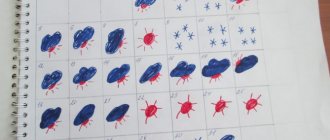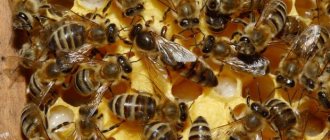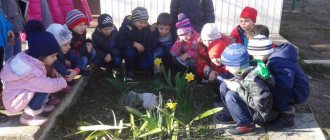Summary of the walk “Watching the sun in spring”
Alla Yuryevna Kotova
Summary of the walk “Watching the sun in spring”
The purpose of the walk : using an example, to consolidate children’s knowledge that in the spring the sun begins to shine brighter and more often; daylight hours become longer; the relationship between living and inanimate nature; the importance of the Sun for all life on Earth.
Draw the attention of children that when they come to kindergarten in the morning it is already light. Compare what it was like in winter at that time (it was still dark, the sun had not yet risen , we had to turn on the lights in the group) During the day, the sun is high and already warms up the air and the ground . green grass appeared. buds are blooming on the trees. conduct an experiment with children “Properties of sun rays ”.
Purpose: to experimentally demonstrate the properties of sunlight .
Procedure of the experiment: on a sunny day, while walking, wet rubber balls, put them in the sun and observe . how they will dry.
Invite children to touch the wall of the veranda on the sunny side and on the shady side. Ask why the wall is cold in the shade and warm in the sun .
Offer to expose your palms to the sun and feel how they warm up.
Signs: birds started singing in the rain - it will soon be clear; in April, clear nights end in frost.
Sayings and proverbs: it’s spring time, I ate from the yard; spring is red with flowers .
There will be no knocking on the door or window,
And he will come up and wake everyone up. ( Sun )
Didactic game “Name it affectionately.”
Goal: to learn to select words in diminutive form.
P/game “ Sunshine and Rain ”.
THANK YOU FOR YOUR ATTENTION!
Summary of the walk “Observing the Sun” Purpose of the walk: to give children an understanding of the role of the sun in the life of animals and plants; develop observation skills and the ability to make basic generalizations. "Watching the Sun" Summary of the walk Purpose of the walk: to consolidate children's knowledge that in the spring the sun begins to shine brighter and more often, so it becomes warmer. Tell the children.
Summary of a walk in the senior group “Observing seasonal changes in spring” “Observing seasonal changes” Objectives: - to form concepts about the change of seasons; — update and supplement children’s knowledge about phenomena.
Summary of the walk “Seasonal changes in nature in spring” in the senior group 1. Observation of seasonal changes in nature in spring. Goal: To consolidate children’s knowledge about the time of year, ideas about spring changes.
Summary of a walk in the second junior group “Walk in the spring” Topic: “Walk in the spring” Purpose: to consolidate in children specific ideas about seasonal changes in nature. Develop cognitive interest.
Observation “Pine in Spring” We live in the amber region of our Motherland. Both adults and children know about amber; many secrets and legends are associated with it; it preserves traces of ancient history.
Observing trees on a walk in spring Observing trees on a walk. Goal: to form ideas about trees. Objectives: to introduce children to the characteristics of trees in spring.
Watching the sun in winter. Photo report In winter in the north, when a long polar night hangs over the Yamal tundra, the sun does not appear above the horizon, and without it it becomes boring.
Lesson summary “Walks in the spring” Continue observing the snow with your child. Compare the color of the snow (gray, dirty) with what it was like in winter. Organize games with snow.
Spring observation with children in spring SPRING OBSERVATIONS WITH CHILDREN IN NATURE. Sun: a) Three-year-old children will notice that the spring sun is warmer, they want to take off their mittens or unbutton them.
Source
Card index of walks
Drawing up a plan for outdoor leisure requires taking into account a number of important points:
- the topic should have something in common with other classes;
- variability is important, since the weather can make its own adjustments (usually the teacher indicates 1-2 alternative topics in the calendar planning for each week);
- the emphasis on this or that activity is done based on the individual characteristics of a particular team (for example, if the kids are athletic, then you can’t do without enhanced physical training during a walk).
Table: sample of drawing up a calendar-thematic plan for walks
| date | Subject | Kind of activity | Tasks | Techniques |
| Autumn | "Wonders of the Wind" | Observation | Strengthen the ability to record changes in nature, tell why and why leaves fall | Game “Pathfinders. Which leaves win” (children analyze which trees there are more on the site) |
| Work | Involve children in helping with plant care as much as possible | Kids shelter flowers from the cold, raking fallen leaves under local trees and bushes | ||
| Games | Train in running, jumping, agility | "Zarnitsa", "Fishing Rod" | ||
| Individual approach | Improve physical fitness, work on developing memory and attention | The game “Get a leaf” for active children, the game “I will put it in the basket” for sedentary children | ||
| Spring | "We are athletes" | Observation | Arouse emotional attitudes towards animals, insects and plants | Discussion of the body structure features of butterflies |
| Work | Learn to run errands on time | Game “Who is faster” (kids collect garbage at speed) | ||
| Games | Develop motor creativity and attention | “Salki”, role-playing games at the discretion of children | ||
| Individual approach | Develop the ability to draw symmetrical images (for overly active children) | Game "Complete the Draw" |
Table: summary of a walk in a preparatory group for school
| Author | Slesarenko Natalia |
| Name | “Expedition through the territory of the kindergarten” |
| Content | < Time of year: late autumn (November). Preliminary work:
Take-out materials: feeders, turntables, spatulas, flags, plastic molds, wooden pencils, multi-colored water in plastic bottles, red and blue ribbons for outdoor play. Goal: increasing vitality through new impressions and knowledge about the environment. Tasks:
<… Observation (central entrance). Q: Guys, do you think weather conditions are important for forwarders? D.: Yes. Q: What weather is best for hiking? D.: Good, windless, clear, sunny. Q: What can we say about the weather now? (Listens to the children’s answers) How can you determine whether there is wind or not? (Look at the trees, turn in different directions and feel the wind with your face, hand, using a flag, ribbon) Q: How can we determine which direction the wind is blowing? D.: Look at the trees (where the trees lean means the wind is blowing in that direction, using a flag or a pinwheel). Children determine the direction of the wind. V.: I suggest playing the game “North and South Wind”. Children choose drivers using a counting rhyme. There are two drivers in the game. The first person is tied with a blue ribbon on his hand - this is the “north wind”, the other - a red one - this is the “south wind”. The rest of the children are running around the playground. “North Wind” tries to “freeze” as many children as possible (touch them with your hand). “Frozen” children take some pose. The “South Wind” “defrosts” them by touching them with his hand, exclaiming: “Free!” After 2-3 minutes, new drivers are appointed, and the game is repeated. V.: Well done, now look at the photo and guess where we will go? (The teacher shows a photograph of the object: the veranda of our site) For a successful expedition, let's remember our motto. D.: “We are smart, we are attentive, we are diligent and everything will work out for us!” V.: And, like real forwarders, let’s walk like a “skier.” Children line up in a column one at a time. When we reach the turn, the teacher asks where to go next (left, another left, straight, right). They walk to the veranda in different ways (snake, step over high snowdrifts, side gallop)…> <… Individual work: drawing on the snow with wooden pencils (drawings from geometric shapes). The teacher praises the children. Q: Guys, where do you think birds gather most during the cold season? (Where there are a lot of trees) Q: Is there such a place on the territory of the kindergarten? Who can lead our expedition there? They continue their journey with different walks: “skiers”, side gallop, “high snowdrifts”, “snake”. They reach the main entrance and enter an area with trees. Q: Guys, what do you call the birds that do not fly south, but stay with us? (Wintering). What wintering birds do we often see visiting birch trees? (Crows, sparrows, magpies). How can we help birds survive a harsh, windy winter? V.: Let's remember the poem: It is difficult for birds to winter, We must help the birds! I asked him to cut a spruce board, and together with my dad I made Bird’s dining room. (A. Chepurov) V.: Our children, together with their parents, also made feeders for the birds, let’s hang them up and, going out for a walk every day, we will pour food for the birds. V.: Guys, I think the birds will be very happy and grateful to you. Result: Today on our walk we were pathfinders, we learned a lot of interesting things about the properties of snow, the friends of trees, and wintering birds. But the most important thing? D.: We were nature’s helpers: we pleased the birds with feeders, took care of the young trees, covered them with fluffy snow so that their roots would not freeze. V.: Thank you very much for this! You made me very happy with your knowledge, remain as attentive and caring towards all living things! V.: Let’s take a photo as a souvenir and tell the children in kindergarten how usefully we spent today’s walk...> |
| Source | Quote from: https://www.maam.ru/detskijsad/progulka-v-podgotovitelnoi-grupe-analiz-progulki.html |
Time plan for the walk
Like any other type of educational activity, the walk must be carefully planned in time. For the preparatory group, the timing is as follows:
- observation - 5–25 minutes;
- labor activity - 7–15 minutes;
- physical activity, including outdoor games - 20–25 minutes in the morning, 12–15 minutes in the evening;
- individual work - 7–15 minutes.
Typically, time delays occur during the play phase: children do not want to change the type of activity
Topic: “Excursion to the autumn park”
- Observation - 20 minutes. Conversation on questions (What new can we observe in the park?, How is the park different today from what we saw in the summer? etc.), the game “I am a birch tree” (kids take turns imagining themselves as trees and using their facial expressions they show what exactly).
- Labor - 20 minutes. Children collect seeds of various plants in separate boxes.
- Physical activity - 25 minutes. Games “Birdcatcher” (a child standing in a circle, blindfolded, tries to catch the one who gave the voice), “Recognize a friend by his voice” (the driver inside the circle closes his eyes, completes all the tasks of the participants, and then tries to guess who is calling him) .
- Individual work - 15 minutes. For active children, the task is to run up to the tree that the teacher names, for calm kids - “Sparrows”: the participants move forward in small jumps.
Topic: “The winds blow in February”
- Observation - 5 minutes. Children use pinwheels to determine the direction of the wind. An explanation of how drifts appear on roads and what drifting snow is.
- Labor activity - 15 minutes. Children remove snow from the paths with the help of shovels and brooms, decide where to place the collected snow, and also create a snow woman.
- Play activity - 10 minutes. Role-playing fun using snow structures and a built snowman. For example, a snowball fight.
- Individual work - 10 minutes. Active children ski, less active children learn to balance on an ice ring.
Structural elements can be combined in different ways, so time periods sometimes change within 5–10 minutes. The duration of the children’s stay in the air is determined by climatic conditions, but it is carried out 2 times a day: after breakfast and after afternoon tea.
This is interesting. According to SanPiN 2.4.1.3049–13 “Sanitary and epidemiological requirements for the structure, content and organization of the operating mode of preschool educational organizations,” approved. By Decree of the Chief State Sanitary Doctor of the Russian Federation dated May 15, 2013 No. 26, the recommended duration of daily walks is 3–4 hours.
Article SanPiN
https://www.maam.ru/detskijsad/statja-progulki-dlja-raznyh-vozrastnyh-grup.html
Preview:
Watching the sun
Age group: Senior
Goal: To develop children's interest in inanimate objects of nature.
Tasks: Continue observing the sun. To consolidate the knowledge that with the arrival of spring changes occur in nature, the sun is the main source of light and heat for all life on Earth, it rises in the east and sets in the west.
Good people, to the red sun,
To the beautiful. (V. Bryusov)
The most important factor determining the weather is the sun - the source of life, light and energy. In spring, the sun begins to rise higher and higher, the more it warms the earth, so the weather is warmer. There is an increase in daylight hours. The sun rises in the east and sets in the west.
The teacher asks the children questions.
♦ What has changed with the arrival of spring?
♦ What has begun to appear more often in the sky?
♦ By what signs can you determine that spring has already arrived?
♦ What happens to plants when the sun shines brightly and for a long time?
Purpose: To introduce children to the compass and its purpose. Teach children to determine the cardinal directions using a compass and correctly name them: north, south, west, east.
Materials: compass, cards indicating the cardinal directions.
Game "Magic Circle", "Geese-Geese".
Goal: To train children in the ability to determine the direction of running according to the verbal instructions of the teacher (north, south, ...), quickly take a place in the circle.
Goals: To consolidate skills in jumping to the right, left, soft landing, on half-bent legs, in long jumps from circle to circle.
Clearing the steps on the veranda from snow, collecting removal material.
Goal: develop the desire to work together, helping each other.
Source
Card file of observations for walks in the preparatory group. Spring
The preparatory group is attended by children of senior preschool age - 6-7 years old. For a child, this period is considered responsible. It is designed to prepare children for school. The teacher’s task is to create conditions for learning and conduct classes that will prepare the child intellectually, morally and physically for school. And also quickly adapt and socialize in first grade.
Children on a walk
The teacher of the preparatory group selects materials and prepares notes for intellectual and entertaining classes in accordance with the Federal State Educational Standard. Children learn better and remember new material faster if it is presented in an interesting and playful way.
When teaching children to observe the surrounding nature, the cognitive process should be gradual. Children should see how nature changes month by month and analyze each change together with the teacher.
This complex process involves the child's cognitive functions, such as:
- speech;
- thinking;
- attention;
- auditory, visual and tactile perception.
By the end of the preparatory group, the children receive basic knowledge about living and inanimate nature and understand the role of humans in it.
Observation of living and inanimate nature
Purpose: to give an idea of spring and the change of year.
Studying icicles up close
Observation March preparatory group: Go out with the children for a walk, preferably on a sunny day. Tell that March is the first month of spring. The sun gets warmer and the snow begins to melt. It gradually turns into water, which is absorbed into the soil. The plants drink it and their growth begins. The first grass appears, and leaves grow on the trees and buds swell.
Tell a rhyme:
Spring has arrived. In the spring, the buds swelled and the leaves hatched. Look at the maple branches - How many green noses there are! Author: T. Dmitriev
Additional Information. Show the children icicles and explain how they appear. Offer to place a bucket under the dripping icicles. Let the children observe how much water collects. Then, water the plants with this water.
Watch the snow melt. Let the guys take shovels and clear the paths. The snow will be placed in the sun and in the shade. They will observe where it melts faster. The teacher must explain why this happens.
Read S. Marshak’s poem “March”: The loose snow darkens in March, the ice on the window melts.
Observe the operation of a snowblower. Explain that she takes the snow to the fields where it melts. Tell why they do this. Invite the children to play: whoever removes the snow faster will jump further up from their spot.
Talk about animals. In spring, migratory birds arrive and wild animals, such as bears, emerge from hibernation. Later, when it gets warm, the birds will begin to build nests and have chicks. The animals will have offspring. In the group, show pictures of who has which animals.
Observations in March in the preparatory group are of an introductory nature.
Bird watching in spring
Purpose: to show the life and behavior of birds in spring.
Building a bird feeder in early spring
Observations:
- In the yard the children can see sparrows, tits, pigeons and rooks. The teacher says that birds select a mate, build nests and lay eggs. One bird hatches them, and the other carries the worms for food, because the eggs cannot be left behind. Explain why.
- Children listen to birdsong. Together with the teacher, they hang up the feeder and put food in it. Explain what birds eat.
- Explain what hatched chicks eat and how they learn to fly. Until November, migratory birds fly to warm countries for the winter.
- The teacher asks questions about the material covered.
- Invite the children to clean up the area. Divide them into groups and monitor their joint work.
- Play: let the children be birds and run away from the teacher. Take the ball and ask them to hit the target, so the guys will develop their eye and strength.
How to teach a child to count - effective and proven methods
Weather observation
Goal: develop observation skills.
Observations:
- Children notice changes in the environment every day: the snow around is melting, the sun is getting warmer every day, the sky is clearing. The clouds become lighter and blue skies are visible more often. Explain how clouds form. In May the sky turns bluish.
- In early spring there is frequent rain and hail. Tell where they come from and why. There is a temperature difference - the higher, the colder. There, the steam that rises from the water on the ground turns into ice. Rain often comes with hail.
Ask a riddle:
Fluffy cotton wool: Floating somewhere. The lower the cotton wool, the closer the rain. (Cloud)
Additional Information! Invite children to sprinkle sand on the paths. Remove trimmed branches from trees and bushes.
Watching the sun
Goal: Find out how the sun affects plants, animals and humans.
Observations:
- Tell that with each spring day the sun gets higher and the days get longer. It rises from the east and sets in the west. Show cardinal directions. The sun's rays hit the plants and because of this, their growth occurs. For good health and well-being, you need to be in the sun as often as possible.
- Invite the children to touch the stones. Those on which the sun's rays fall become warm because they heat up. And the stones in the shade remain cold.
- Explain that planets revolve around the sun.
- Play: the teacher is the sun, and the children are the planet. They walk around and then run away. The teacher catches them.
Additional Information! Bring sunglasses with dark lenses. Tell them that they protect the eyes from bright rays.
Birch tree observation
Goal: to develop knowledge about birch.
Birch tree observation
Observations:
- Show tree. Let the children remember what it looks like.
- Tell that the birch tree has roots. They are strong and go deep into the ground. Roots are needed for the tree to stand strong in the wind. Birch, with the help of its roots, consumes moisture and nutrition from the ground. In the roots they turn into juice, which rises first up the trunk, then into branches and leaves. If you make a hole, it will flow and you can drink it. In April, birds make nests on birch trees, insects land and caterpillars crawl, which then turn into butterflies. In winter, in February, hares eat the bark because there is little food for them at this time. Tell that in autumn the leaves on the tree turn yellow and fly off.
- Offer children a game where they will list all the trees they know.
- Let the children collect fallen branches from the area.
- They will learn to walk in formation.
Soil monitoring
Goal: find out information about the land.
Observations:
- Let the guys observe in which place the earth dries out faster. Explain why this depends on sandy soil more quickly than on clayey soil. Sandy soil is looser, it absorbs water faster and lets it pass through it deeper. Clay is more dense, so the process of moisture absorption occurs more slowly and in early spring this takes about a week. Let the children note that plants grow better and faster in sandy soil.
- Invite the children to dig up different soils and compare them themselves. See that there are small roots, sticks and leaves in the ground. Let them take a watering can and water the soil one by one, and see which one dries out faster.
- Give the children the task of bringing fresh soil under some tree roots.
- Play jump rope, exercises with which strengthen muscles and develop coordination of movements.
Breathing exercises for children 4-5 years old in kindergarten




